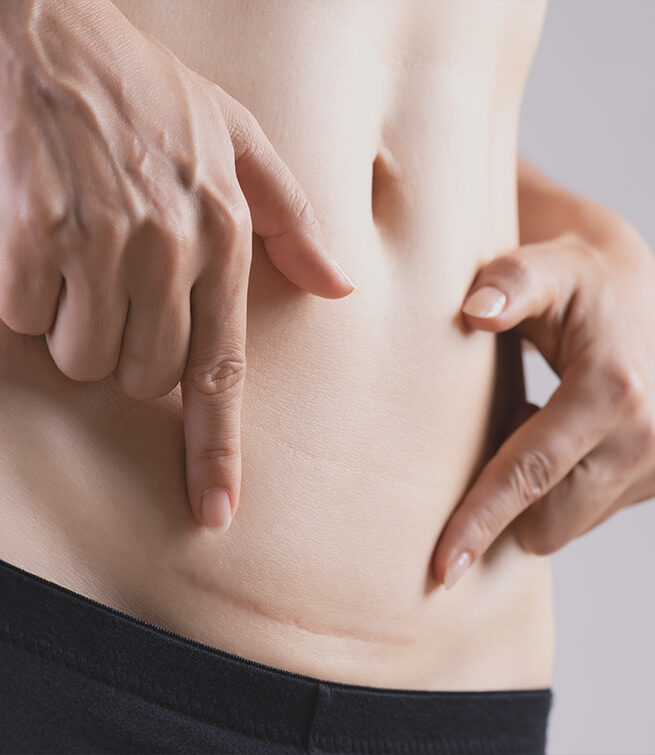Cosmetic surgery: living with scars
Scars mark the passage of time and the challenges we face. They can be left by trauma, a deep cut or burn, or surgery.
Although they can fade with time, they never completely disappear. Thus, we have to learn to live with our scars. This article will give you some tips for living more comfortably with these marks.
What is a scar?
A scar appears when the second layer of the skin, the dermis, is affected by a skin injury. The skin begins the process of repairing and regenerating itself, known as scarring. It is an integral part of the healing process.
The stages of scarring
Whether it occurs after an injury or a surgical procedure, scarring follows the same stages. If you are planning to undergo cosmetic surgery in the near future, here are the stages of healing you will experience.
Up to two weeks after the operation: the scar will be thin. The skin is multiplying its cells and producing new components of the dermis.
Up to six months after the operation: you may observe inflammation of the scar. The temperature on and around the scar may increase. Redness, swelling and pain may accompany this local rise in temperature.
You may also feel itching. But don’t worry, all of these feelings are a normal part of the healing process.
Up to two years after the operation: the scar lightens. It fades and becomes more supple. You will not feel any physical pain or discomfort around the scar.
A few tips for improving the appearance of scars
Although they will never disappear completely, there are a few things you can do to promote good scarring.
Moisturize your skin
Moisturize your skin several times a day. Vegetable oils or specialized creams will give your skin all the flexibility it needs. This way, you will greatly reduce potential feelings of burning, itching and twinges of pain.
Don’t forget — good moisturizing is also achieved by drinking enough water. Drink several glasses of water per day!
Protect your skin
After the operation, the surgeon will apply bandages to the site of the procedure. They will protect your skin from rubbing against your clothes and promote healing.
Other factors may also influence how well scars form. People with darker skin may notice more apparent scars. Diabetes, poor diet, smoking, or a vitamin/mineral deficiency may also be factors that affect the production of collagen in the skin, making the scarring process more difficult.
Scars from cosmetic surgery
Like any surgical procedure, cosmetic surgery leaves scars. However, cosmetic surgeons are masters of disguise. They work with the curves of the body so the marks left by their interventions are as subtle as possible.
In addition to placing the incisions for the surgery in the most discreet areas possible, your surgeon will ensure that the edges of the wound do not overlap during stitching so that the smoothest possible scar will form.
Your surgeon will also use the thinnest possible stitches, and surgical staples will be avoided. The use of bandages will also help your skin to stay moisturized. Your surgeon may also use silicone-based bandages that, when used with pressotherapy, can improve scars: applying pressure to scars often improves their appearance.
For a rhytidectomy (facelift), the scar will be located near the ears: either on the temples, hidden in the patient’s hair, in the folds in front of the ears, or behind the ears.
For rhinoplasty, the scar will be located under the nose. It’s barely visible, even though it’s in the middle of the face!
For breast surgery, the scar, shaped like an upside-down T, will appear under the nipple and in the fold under the breast. The surgeon may also place it around the areola or in the armpit.
The incision for a thigh lift is usually in the form of a backwards L that goes from groin to knee, depending on how much excess skin is removed. The scar is very discreetly located on the inner thigh.
Your surgeon will apply the same principle for arm lifts, locating the incision along the inner arm from armpit to elbow.
Lastly, abdominoplasty produces a very discreet scar on the lower abdomen, near the pubis. It is easily hidden under your clothes and will not prevent you from putting on your swimsuit!
Cosmetic surgery to reduce the appearance of scars
Perhaps you are reading this article because you are living with one or more scars that embarrass you. Microdermabrasion is a technique that reduces the appearance of keloid scars or scars left by acne or chickenpox.
This technique involves exfoliating dead skin cells. In three or four sessions, the surface of the skin can be levelled with the deeper scars.
Laser treatment for scars can also help reduce redness.
In other cases, the surgeon may suggest a surgical procedure to remove the scar. Iterative excision removes the flawed scar (such as a hypertrophic scar). It takes place over a few sessions to allow the skin to relax between each session. It must be noted that this procedure also leaves a scar. However, it will be smoother and more discreet.
Lastly, your surgeon may also use a skin graft to correct the appearance of an embarrassing scar.
To learn more about the process used by your surgeon and what to do before and after your surgical procedure, feel free to meet with me for a consultation.
Back to blog
